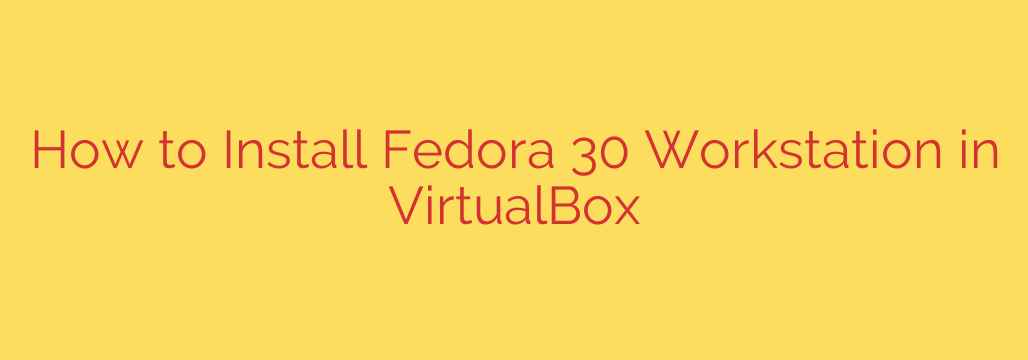
Installing a modern Linux distribution like Fedora Workstation within a virtualized environment offers immense flexibility for testing, development, or simply exploring without altering your host operating system. Oracle VirtualBox provides a robust platform for this purpose. Here’s a comprehensive guide to getting Fedora Workstation set up seamlessly in VirtualBox.
Before you begin, ensure you have Oracle VirtualBox installed on your host machine and the Fedora Workstation installation ISO file downloaded. You’ll typically find the ISO on the official Fedora Project website.
Creating Your Virtual Machine
The first step is to set up the virtual hardware for your Fedora instance. Open VirtualBox and click the New button.
Give your virtual machine a descriptive Name, such as “Fedora 30 Workstation”. VirtualBox is often smart enough to automatically detect the Type as “Linux” and Version as “Fedora (64-bit)” based on the name, but confirm these settings are correct.
Next, allocate Memory size (RAM). For Fedora Workstation, a minimum of 2048 MB is recommended for a smooth experience. More is always better if your host machine can spare it.
For the hard disk, select Create a virtual hard disk now and click Create. Choose VDI (VirtualBox Disk Image) as the file type. For storage, select Dynamically allocated. This means the virtual disk file will only grow as data is added inside the virtual machine, saving space on your host disk initially.
Allocate a sufficient size for the virtual hard disk. Fedora requires a decent amount of space; 20 GB is a reasonable minimum, but 30-40 GB provides more breathing room for applications and updates. Click Create to finalize the virtual machine creation.
Configuring Virtual Machine Settings
With the VM created, you need to attach the Fedora ISO to it. Select your newly created VM in the VirtualBox main window and click Settings.
Go to the Storage section. Under the Storage Tree, select the Empty CD icon listed under the IDE controller. On the right side, under Attributes, click the small CD icon next to “Optical Drive” and choose Choose Virtual Optical Disk File…. Browse to the location where you saved the Fedora Workstation ISO file and select it. Click OK to save the settings.
Starting the Installation
Now, start the virtual machine by selecting it and clicking the Start button. The VM will boot from the attached Fedora ISO.
You will be presented with the Fedora boot menu. Choose Install Fedora Workstation. The Anaconda installer will load.
Walking Through the Fedora Installer
The installer is graphical and straightforward.
- Language and Keyboard: Select your preferred language and keyboard layout and click Continue.
- Installation Summary: This screen shows various configuration options. Items with a warning triangle need attention.
- Installation Destination: This is crucial. Click on it. Select the virtual hard disk you created (it should be the only one listed). You can choose Automatic partitioning for simplicity, or Custom if you need specific partition layouts (though Automatic is usually fine for a VM). Click Done. If you chose Automatic, it will prompt you to accept the changes; click Accept Changes.
- Network & Host Name: Configure your network settings if necessary. DHCP is usually enabled by default and works fine in VirtualBox. You can set a hostname here if desired.
- Time & Date: Verify the time zone settings are correct.
- Software Selection: Workstation is pre-selected. You can optionally customize software here if needed, but for a standard setup, just leave it as is.
- Begin Installation: Once all necessary items are configured, click Begin Installation.
While the installation files are being copied, you can configure user settings:
- Root Password: Click this option to set a password for the root user. While not strictly necessary if you create a standard user with sudo privileges, it’s good practice to set one.
- User Creation: Click this option to create a standard user account. Fill in the full name, username, and password. It’s highly recommended to check the box Make this user administrator to give them sudo privileges.
Wait for the installation process to complete. This might take some time depending on your hardware and the resources allocated to the VM.
Finishing Up
Once the installation is finished, a message will appear indicating success. Click Finish Installation.
Before rebooting, it’s a good idea to unmount the Fedora ISO from the virtual CD drive. In the VirtualBox window menu for your running VM, go to Devices -> Optical Drives and uncheck the Fedora ISO file. This prevents the VM from booting back into the installer.
Now, Reboot the virtual machine. It should boot from the virtual hard disk into your newly installed Fedora Workstation environment.
Post-Installation
After logging in for the first time, follow any initial setup prompts within Fedora. A crucial step is to install the VirtualBox Guest Additions. These additions provide drivers for better graphics performance, mouse integration, shared clipboards, and other features that significantly enhance the VM experience. You can typically install these from the VirtualBox menu under Devices -> Insert Guest Additions CD image…. Then, open a terminal within Fedora, navigate to the mounted CD image directory (often /run/media/username/VBox_GA_*/), and run the installation script (usually sudo ./VBoxLinuxAdditions.run). You might need to install some prerequisites like kernel-devel packages first.
Finally, open the Software application or use the terminal (sudo dnf upgrade) to perform a full system update to ensure all your software is current and secure.
You now have a fully functional Fedora 30 Workstation running inside VirtualBox, ready for you to explore!
Source: https://kifarunix.com/install-fedora-30-workstation-on-virtualbox/








